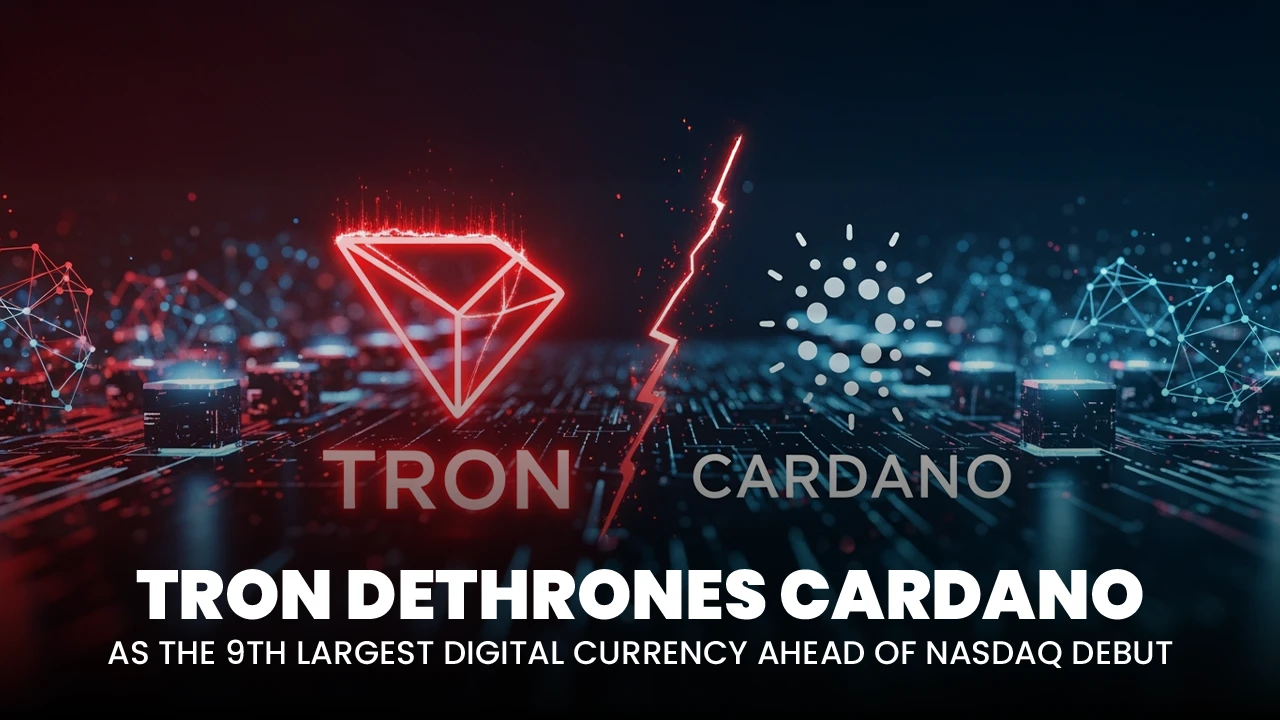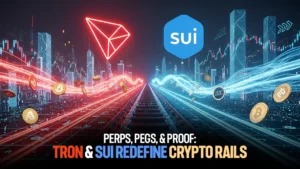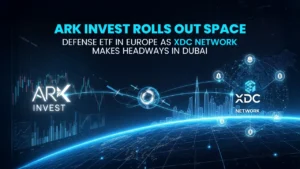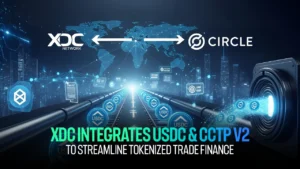TRON Celebrates Nasdaq Debut, Dethrones Cardano as the 9th Largest Digital Currency

In a major development on Monday, TRON (TRX) overtook Cardano (ADA) to become the ninth-largest digital asset by market capitalization. This shift follows a 30% increase in TRX’s daily trading volume, which reached $1.64 billion in the lead-up to TRON Inc.’s official listing on the Nasdaq on July 24, 2025.
The move reflects a broader trend within the blockchain sector, where networks built for transaction speed, scalability, and operational efficiency are gaining momentum among both retail users and institutional investors. As adoption continues to grow, infrastructure that can support high-volume demand is becoming a critical factor in market positioning.
TRX Volume Surge Drives Market Capitalization Lead
TRON’s native asset, TRX, saw a sharp spike in daily activity. Its market capitalization climbed to approximately $30.1 billion, pushing past Cardano, whose ADA token dropped nearly 10 percent to a market value of $29.3 billion.
The timing of this shift aligned closely with TRON Inc.’s debut on the Nasdaq exchange under the ticker symbol “TRON.” Founder Justin Sun marked the event by ringing the opening bell in Times Square, signaling the start of a new era for the project in traditional finance.
Nasdaq Listing Brings Institutional Visibility
TRON Inc.’s Nasdaq listing brings new exposure to institutional investors. According to CEO Rich Miller, the listing is designed to enhance shareholder value and facilitate greater regulatory clarity.
Behind the market momentum is a strong technical framework. TRON operates on a DPoS-based model, which allows it to confirm transactions rapidly and at low cost. This setup supports high performance across various use cases, including decentralized finance and stablecoin settlement.
Gas-Free Upgrade Reduces Fees, Increases Utility
Earlier this year, TRON introduced a Gas-Free feature that reduced average transaction fees by about 70 percent. Fees dropped from 2.47 TRX to just 0.72 TRX, making the network more attractive to both developers and users.
The upgrade has already delivered results. TRON now supports over $80 billion in USDT circulation, making it one of the most active platforms for stablecoin transfers globally. This rise in utility reflects how infrastructure improvements can directly translate into broader adoption.
The success of these updates is made possible by TRON’s consensus approach. Its DPoS structure enables the network to handle large transaction volumes while remaining decentralized and energy-efficient.
Cardano Remains Strong Despite Short-Term Drop
While TRON moves ahead in market ranking, Cardano continues to maintain a strong foundation. The network relies on Delegated Proof of Stake, a protocol that ensures security and scalability through community-powered validation.
Although ADA has recently lost ground in price performance, the Cardano ecosystem remains highly active. With initiatives like CardanoKit and integrations such as Apple Pay support, it continues to build for long-term usability in real-world applications.
Cardano’s model prioritizes sustainability and decentralization, making it well-suited for mobile payments and decentralized apps even as market volatility fluctuates.
Comparing TRX and ADA
| Metric | TRON | Cardano |
| Market Rank | 9th globally | 10th globally |
| Market Cap | Approximately $30.1 billion | Approximately $29.3 billion |
| Daily Volume | $1.64 billion, up 30 percent | Lower volume, ADA down 10 percent |
| Consensus Mechanism | DPoS-based for high speed and low cost | Delegated Proof of Stake for secure, scalable performance |
| Institutional Signal | Nasdaq listing, public exposure | Focused on payment integration and open-source tools |
Conclusion
TRX’s rise past Cardano highlights a shift in market dynamics. With rising volume, a Nasdaq listing, and a fee-reducing Gas-Free feature, TRON has demonstrated its ability to meet real-world demands. Its DPoS-driven network structure has allowed it to scale quickly while remaining efficient and accessible.
Cardano, backed by its Delegated Proof of Stake architecture, remains a major player in blockchain development. Its focus on accessibility, decentralization, and long-term sustainability keeps it well-positioned for the future.
Together, these networks demonstrate how blockchain protocols designed for performance and adaptability are emerging as the centerpiece of the next phase of digital finance.
Frequently Asked Questions (FAQs)
- Why did TRX overtake Cardano?
TRX’s trading volume surged 30 percent, reaching $1.64 billion, while Cardano’s ADA declined. The momentum was fueled by TRON Inc.’s Nasdaq debut and the increased utility of its network. - What is TRX’s Gas-Free feature?
It is a network upgrade that reduced transaction fees by around 70 percent, encouraging greater on-chain activity. - When did TRX go public?
TRON Inc. was officially listed on Nasdaq on July 24, 2025, under the ticker “TRON.” - What makes TRX’s network scalable?
TRX uses a DPoS-based model that supports high-speed, low-cost transactions while maintaining decentralization. - How does Cardano maintain network performance?
Cardano operates on Delegated Proof of Stake, ensuring secure, energy-efficient, and scalable operations.
Glossary of Key Terms
- TRX: The native digital currency of the TRON blockchain.
- ADA: Cardano’s native cryptocurrency.
- Nasdaq Debut: TRON Inc.’s official listing on the Nasdaq stock exchange.
- Gas-Free Feature: A 2025 TRX upgrade that cut average transaction fees significantly.
- DPoS-Based Model: A consensus mechanism where users delegate voting power to validators, improving transaction speed.
- Delegated Proof of Stake: Cardano’s consensus approach that balances decentralization with network efficiency.
- Market Cap: The total value of a cryptocurrency’s circulating supply.
- Stablecoin: A cryptocurrency pegged to the value of a stable asset like the US dollar.
- On-Chain Activity: Any transaction or interaction recorded directly on a blockchain network.
- Institutional Investment: Financial involvement by entities such as banks, hedge funds, or exchanges.




